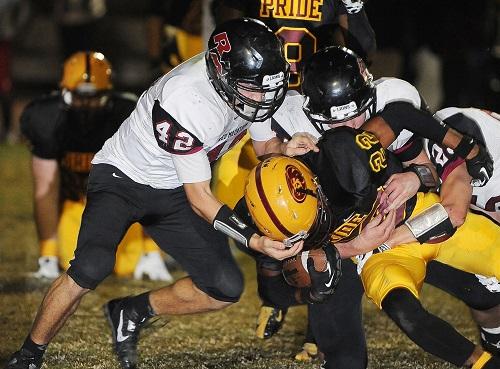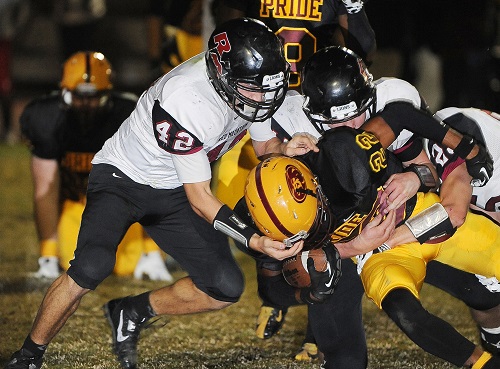

In Connecticut, there’s a different philosophy: Play anyway. And it’s all because an independent and private full-contact football league started up with the concept of giving high school athletes the chance to compete, something that could serve as a precedent in other states and in other programs.
The Hartford Courant broke the story in late October. Several area high school football teams were represented in the upstart Connecticut High School Independent Football League, which was created shortly after the Connecticut Interscholastic Athletic conference canceled full-contact football game play this fall at the recommendation of the state’s Department of Public Health.
The new league’s teams were operating independently of their respective schools, though in many cases, teams were using equipment loaned from the local school boards and are being run by the high school team’s coach.
“We kind of just said, ‘We’re going to find a way to make it happen,’” coach Kevin Frederick told The Washington Post as he stood on the sidelines.
While Connecticut is among 15 states and the District of Columbia that have upheld postponing football until the spring season, it is believed to be the only state that has had independent leagues form as a result.
According to the Washington Post article, the league was co-founded by Daniel Lacasky, the owner of a semiprofessional team in the state, according to a GoFundMe page for the league. (Another founder is Mark Siems, also the leader of a semi-pro team).
At least one other independent league reportedly was formed in Fairfield County, and online fundraisers have been launched to support teams that consist of players from different schools.
Not a moment too soon, said the league's officials.
“The parents were in an uproar, the community was in an uproar, saying, ‘We need these kids to play,’ ” said Rob Kosienski, the president of Meriden’s Board of Education. “We’re giving these kids the opportunity they deserve.”
The league, which quickly gained nearly 20 teams, was able to leverage the use of facilities and equipment, thanks to a decision from the local school board. That saved some money, but teams were then forced to raise thousands of dollars to cover insurance, referees, medical personnel and announcers for each game.
Governor Ned Lamont said in October that he did not plan to interfere with the independent football leagues because “we’ve always thought of education and local sports as more of a local priority;” however, he warned that independent football activity could risk a spread of the virus within schools, most of which are using a hybrid model of in-person and online learning this fall.
According to Siems, not everyone was as supportive. Many teams had to fly under the radar to have practices, he told Connecticut Insider in an article that was published on the league’s Facebook page.
“We have clubs practicing at (Quassy) amusement park, at a regional airport, on a farm, in somebody’s back yard, because their towns — some clubs are made up of multiple districts — aren’t being supported whatsoever. We’re worried that their local towns would shut them down or put pressure on the parents not to let them play. It has happened a lot.”
But, he added, the league is safe. It takes its cues from teams he and Lacasky operate.
“We had games since July, played from Connecticut to Maine,” said Siems. “We just finished our league championship. Spectators, players, coaches, staff, not one instance of infection. Documented. Not one. We’re required to do contract tracing at every game. If there is an issue, we have the paperwork on everyone who walked in the door. Our protocol is proven.”
The article noted that the next logical question was where the league would lead. Could it, for example, end up as the first step in AAU-style high school football?
Siems said he was aware of the implications. And, the article added, with so much infrastructure in place to reduce costs, many hurdles already are cleared. Could another league run in the spring? How would a league promoting talent for colleges affect prep schools and public schools’ ability to field teams this spring – if, in fact, they can?
“These pop-up leagues could have some ramifications in our state in the future,” said Ledyard AD Jim Buonocore, who’s also on the CIAC football committee.
But as October bled into November, there were changes afoot. The Hartford Courant noted that K-12 athletes playing medium-risk sports in Connecticut, including hockey and basketball, would be required to wear masks, as per new rules promulgated by Lamont. (The mask mandate does not apply to college or professional teams). Additionally, the so-called high-risk sports for those age groups would not be allowed to play games for the rest of 2020. Those teams can still practice and condition together, but competitive play is out. The sports classified as high-risk include wrestling, boys’ lacrosse — and tackle football. And the new rules will preclude play at an independent level as well. A note on the group's Facebook page, publilshed on Monday, noted, "We are NOT done, just on hold. We have more to play."
Additionally, Lacasky noted in a separate post, the league had been a learning experience for the players:
"I hope the kids learned that
1) people will fight for them
2) that football is a great unifier.
3) if someone tells you 'no' to a life choice you want, you FIGHT. You fight like hell. You do what makes you happy, and to hell with the rest
4) I hope they realize this isn't the end. CHSIFL isn't going away. If spring restrictions are lessened, but no NFHS sanctioned sports are happening, we will be here.
And in the future, we will be off-season club ball. Football year round? That's a dream for me."
But for that upstart league, there was a win anyway – even if it was a moral victory. An October game marking a traditional rivalry between two high schools, Pratt and Maloney, did take place – albeit in the independent league, and with the players wearing uniforms reading Eastsiders and Westsiders, rather than their high school names. A total of 150 fans attended the game, each required to sit at a distance and wear a mask.
“It was a far cry from the school-sanctioned rivalry game, called the Stoddard Bowl, the town had experienced on Thanksgiving for years,” noted The Washington Post. “But Coach Frederick came prepared, bringing the rivalry trophy. After the game, both teams posed for a photo — triumphantly and defiantly — with the trophy.”
“I was just happy to be out there and play,” said Josh Pelletier, a senior offensive lineman for the Eastsiders. “We knew who we were going against and what we had to do.”
It didn’t sound like the Westsiders were the opponent he meant.

